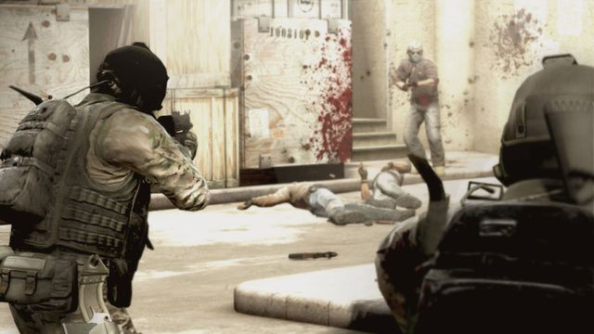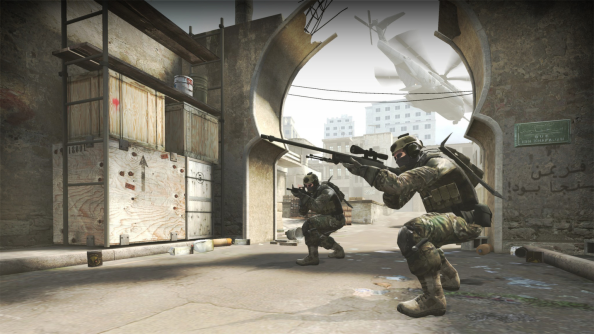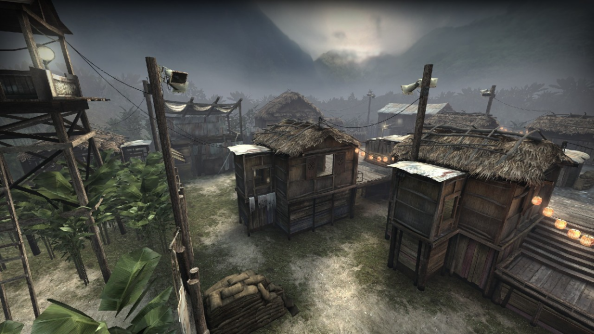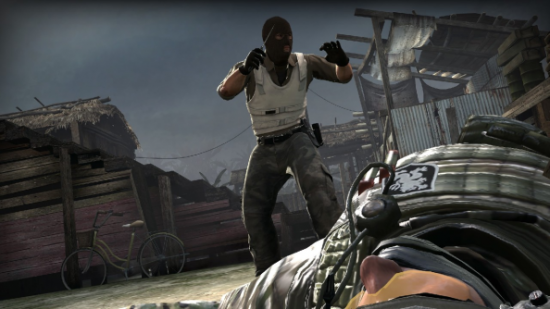By Mitch Bowman
There was a time not so long ago when Counter-Strike appeared to be a dying game. As competitive esports, both the original game and its successor, Counter-Strike: Source, were waning in popularity. Source had been hit particularly hard by the 2008 demise of the Championship Gaming League, the largest competitive league for the game, and original CS (generally referred to as “1.6” by players), was being eclipsed in the public eye by the RTS and MOBA esports du jour.
Even in 2012, with the release of a major new version of the game, Counter-Strike: Global Offensive, things were still looking grim. Many of the organizations that had kept competitive CS alive had folded, leaving a dearth of leagues and tournaments for professional players to compete in. To make matters worse, CS:GO itself was simply not very good when it first launched, and most pros were more inclined to stick with Source or 1.6.
Fortunately, game development is a little bit different these days than it was when CS debuted in 1999. Post-launch support is now an integral part of any multiplayer game release, and Valve has gone further in actively supporting and listening to the competitive CS:GO community than they ever have for previous CS games, and they’ve turned CS:GO from a mediocre iteration into the definitive competitive version of Counter-Strike.
The results in this change of heart from Valve have been hugely positive. Almost exactly one year ago, Dreamhack Winter 2013 hosted the largest CS tournament in the 14-year history of the game, with a prize pool of $250,000. History was made, and since then, three more tournaments of the same size have taken place, all with a Valve-sponsored prize pool and a new game feature that allows the tournament matches to be watched from inside the game client.
Not only have the prize pools gotten (and stayed) larger than ever before, the number of people watching these tournaments has increased steadily, too. On the last weekend of November, Dreamhack Winter 2014 hosted the 4th CS:GO “major” (as these $250,000 tournaments have come to be called), and viewer numbers once again broke the record set by the previous major. Over half a million people watched the final match between LDLC and Ninjas in Pyjamas, with around 300,000 watching the main Twitch stream alone.
The tale of how Counter-Strike’s death spiral was reversed is complicated, and many of the pro players and event organizers who lived through it will all have a different take on how their fortunes were reversed. A confluence of circumstances, both to do with the game itself and with the world of esports in general, have all contributed to this reversal of fate.
Scott “Sirscoots” Smith has a particularly long view of Counter-Strike’s history. He’s been playing the game since the day the public beta became available in June of 1999, and over the last 15 years, he’s done everything from managing pro teams, to helping launch the esports coverage outlet GotFrag TV, to his current gig as the host of the analyst desk at Dreamhack and ESL One’s big tournaments.
He’s of the opinion that Valve’s direct support of the game as an esport has made all the difference. “For years Valve did not care at all, because it was a mod of their game, and even when they bought it and made Source, they didn’t really care,” Smith says. “It took forever to get things patched – it was community driven. It was fine, it thrived without them, but to have developer support of your game – especially an esport – is an incredible added bonus, especially nowadays.”

This has become increasingly true of major esports games in recent years. Studios like League of Legends creators Riot Games have been providing huge financial support for tournaments recently, and even run their own official World Championship series. Valve has done the same for their other big esports success, DOTA 2. Meanwhile, Blizzard has lagged behind in this regard, and the negative effect this has had on the competitive scene for StarCraft II has been notable.
Beyond their direct support of the competitive community, Valve has also made a big effort to make CS:GO a worthy game to be played competitively in the first place. Smith remarks that “Valve [has taken] all our criticism to heart … they understand that our complaints about gameplay issues fix the game for everybody, whether it’s map stuff or gun stuff, and they’ve started patching stuff and fixing stuff on a very regular basis. The game that came out a couple years ago is not the game we’re playing now, and that’s amazingly cool.”
Unlike the Source days, Global Offensive has been getting constant love from Valve, in the form of tweaks and balance changes that often arrive once a week or more. Just in the last month, there’s been some huge updates to the game that have improved its balance immensely; foremost among these has been an adjustment that reduces the power of the CZ75-Auto, a pistol that has been oft-complained about for being too good since its addition to the game. A legendary map has also gotten a complete rework recently, with stellar results. Valve’s effort in this regard has paid off, and the state of CS:GO today is a far cry from the poorly-received game that launched two years ago.
They’ve also found a way to make things work financially, for both themselves and the teams that play their game for a living. The introduction of weapon skins is a trick straight out of Valve’s Team Fortress 2 handbook, and has given them a long-term revenue stream so they can continue to give the game the constant attention it requires.
Over the last year, Valve has also introduced in-game items that directly benefit professional teams. For example, you can buy a sticker of a team’s logo to put on your gun, and the team gets a cut of however much people spend on those. On top of the bigger-than-ever tournament prize pools, this has given esports organizations a way to sustainably play Counter-Strike for a living, even if they’re not winning every event they attend.
Despite all this focus on the competitive side of the game, CS:GO’s developers have also made a version of CS that’s far more accessible for new players than any of the previous iterations have ever been. A ranked matchmaking system, similar to those of League of Legends or DOTA 2, ensures players can play against people of a similar skill level to them, rather than having to join a random server and hope they don’t get stomped, which was the Source/1.6 way of playing. There’s also casual game modes like Arms Race, which always existed in older CS games as mods, but are now official game modes. The value that this accessibility offers in terms of turning new players into fans or participants in the competitive scene is hard to measure, but it certainly can’t hurt.

Not all of the hard work required to make CS:GO the success it is today has been done by Valve. Some fortunate outside forces have also acted upon the fate of Counter-Strike, and the rest of the esports world along with it. The huge success of live streaming platforms like Twitch, perhaps more than anything else, has been an enormous driving force behind the ability of esports to reach a wider audience than ever before.
“I think all esports have grown because of the ability to stream for free,” Sirscoots says. “The idea that I can grab good bandwidth, and monetize it fairly inexpensively, has absolutely helped explode esports. You want zero barrier of entry to this content, and Twitch is now the beast that provides that. And they’re very, very actively involved in supporting esports. It’s not just like ‘Here’s your link, go ahead,’ they love this shit too.”
The number of Twitch staff members and admins who show up in the chat of any major tournament stream is testament to this fact – beyond simply providing the platform for esports to broadcast themselves, Twitch has been a huge advocate for competitive gaming in general.
For many pro players, Twitch has become another revenue stream outside of tournaments, too. On any given evening, you can find a handful of professional CS:GO players streaming their casual practice matches, often with thousands of people watching. Some pros have even said they make more money from their Twitch broadcasts than they do from playing tournaments.
Robin “Fifflaren” Johansson, a (now retired) pro player whose team Ninjas in Pyjamas won the ESL One Cologne major earlier this year, sees another benefit to Twitch’s popularity. “Twitch has helped a lot in the sense that you get so many viewers that have probably never heard of CS before,” he says. “All of the younger generation that started playing League of Legends and whatever, they can go on Twitch and be like ‘Whoa, wait, what’s this game? They’ve got like 300,000 viewers. I gotta check this out.’ And that’s obviously helped the growth of CS:GO.”
The statistics back Robin’s theory up. Not only do the viewer numbers reach new heights every time there’s a major, but the number of people actually playing the game does, too. Something about watching the best players in the world play CS makes people want to try it out for themselves.
Other services and platforms do their part as well. “I think you do have to acknowledge things like the betting sites,” Scott Smith says, referring to sites like CS:GO Lounge, which allow users to bet on the outcome of a tournament match. “There’s no doubt that people having even more vested interest in a team they bet skins on – or now even real money – makes them watch the match more.”

With CS well on its way to regaining its throne as one of the biggest esports attractions around, the question becomes “what’s next?” There’s still plenty of room for growth, as evidenced by the behemoth’s that are League of Legends and DOTA 2’s multi-million dollar tournaments.
For Fifflaren, the answer is something very much like what DOTA 2 has already. “So this major, we had a new record in terms of viewership and the amount of people that are actually playing the game, but I think that’s eventually going to slow down. I think that’s when Valve needs to take that extra step forward and create the CS:GO version of The International.”
The International is DOTA 2’s massive annual tournament, which in 2014 had the biggest prize pool of any esports event ever. Almost $11 million was on the line, most of which was contributed by DOTA players through the purchase of in-game items. The International is an entirely Valve-run affair, much like the first-party-run League of Legends Worlds, which also has an enormous prize pool. So far, CS:GO has no official, first-party tournament like this, and Fifflaren believes that this is a step Valve will have to take eventually if they want CS to continue growing.
Scott Smith, meanwhile, would like Valve to do even more to combat the looming spectre of cheating, with cases of match fixing, exploits, and hacking.
“VAC [Valve’s current anti-cheat system] is an effective system, but it’s a slow system,” Smith opines. “It takes awhile for someone to get tagged. You’re going to play against a cheater, and he’s not going to get tagged as he’s cheating against you; he’s going to get tagged for what he was reported for a month ago, or whatever the timeframe is. I would be absolutely okay with a more invasive anti-cheat client, much like ESEA. I don’t care, I trust you Valve, comb through my files like ESEA does.
“You watch high-level streams of like Hiko and all these pros that stream, and they bump into cheaters all the time. It’s unfortunate, because it ruins it for nine people.”
Both Scott and Robin agree on one thing, and that’s that Valve is on the right track, and the future of Counter-Strike looks bright. With more big tournaments, more gameplay improvements, and more packed Twitch streams, there’s sure to be a lot of CS-related action to look forward to in the coming months and years.
